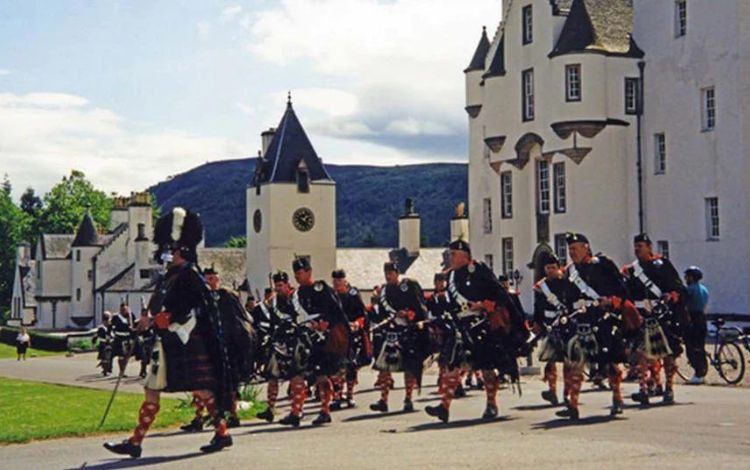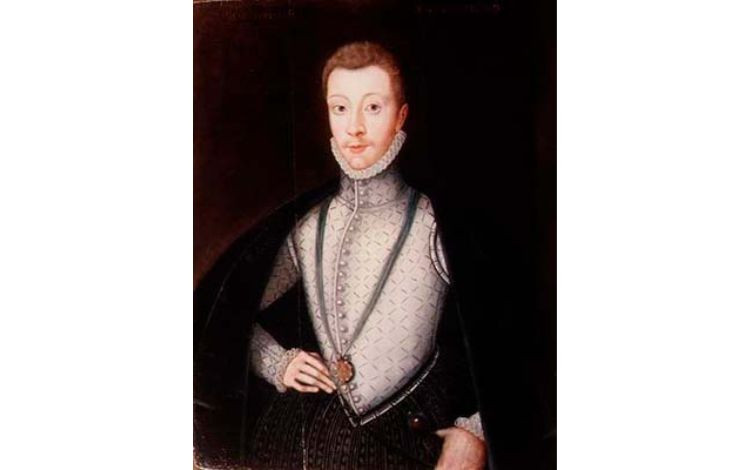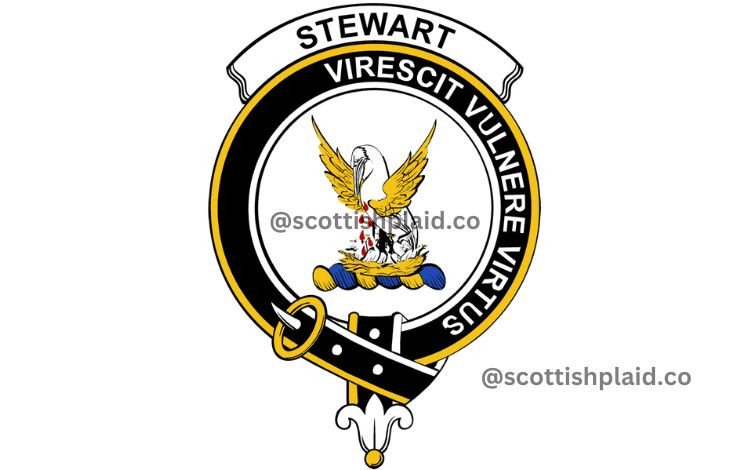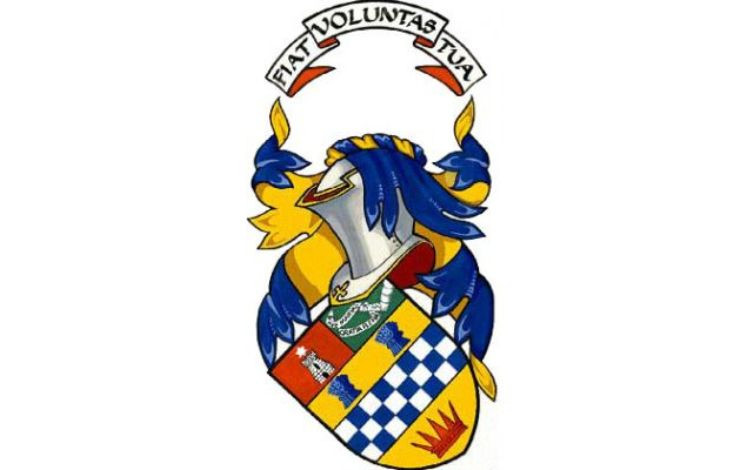Free Shipping For Orders Over $100
Clan Stewart (Tartans, Crest) and The Story Behind
Stewart
Gaelic Name: Stiùbhard
Clan Crest: A pelican Argent, winged Or, in her nest feeding her young, Proper
Clan Motto: Virescit vulnere virtus (Courage grows strong at a wound)
Origin of Name: From Scotland's High Steward
Clan Badge: Thistle
Lands: Renfrewshire, Teviotdale and Lauderdale
Clan Chief: None, armigerous clan
⇨ View All Stewart Tartan Products
Stewart Clan History

The Stewarts trace their ancestry back to Banquo, Thane of Lochaber, who appears as a character in William Shakespeare's MacBeth. However, historically, the family appears to be descended from an ancient family of senechals of Dol in Brittany.
Following the Norman conquest, they acquired lands in England and relocated to Scotland when David I ascended to the throne of Scotland. The family was given extensive estates in Renfrewshire and East Lothian, and the position of High Steward was made hereditary.
We can begin to trace the Royal House of Stewart's descent through marriage with the daughter of Robert the Bruce. The royal line of male Stewarts was unbroken until Mary, Queen of Scots reigned. The Royal Stewarts held the thrones of Scotland and, later, England in direct succession until the death of Queen Anne in 1714. In fact, the current Royal family has Stewart ancestors.
The Stewart tartan is worn by the regimental pipers of the Scots Guards and was referred to as "my personal tartan" by King George V. It is still known as the "Royal Tartan" and is the official tartan of the Royal House of Scotland.
The Stewarts of Appin are the West Highland branch of the great Royal family of Stewart, and have grown to be a significant branch clan. They became Lords of Lorne after marrying into the Lorne family and receiving a grant of lands at Appin. The family seat of the Stewarts of Appin, Castle Stalker, was built on the Cormorant's Rock at Loch Linnhe in Appin. The clan's rallying cry, 'Creag a Sgairbh', or 'Cormorant's Rock,' was derived from this location. Castle Stalker, which was built as a base for royal hunting and fowling expeditions, is still one of Scotland's most beautiful sights.
The Stewarts of Appin were staunch Jacobites, and the famous Appin murder occurred in the aftermath of the 1745 rising. Robert Louis Stevenson immortalized this incident in his novel "Kidnapped." Allan Breck Stewart, the chief of clan Appin, was the main suspect in Colin Campbell's death. He escaped justice, but his half brother was apprehended and tried by a jury made up entirely of Campbell men. He was convicted and later hanged, as one might expect. His execution site is now marked by a cairn.
Another well-known branch are the Stewarts of Atholl, who are direct descendants of one of the most notorious Stewarts of the fourteenth century, Alexander Stewart, Earl of Buchan, also known as "The Wolf of Badenoch." Alexander is best known for leading the raid that resulted in the destruction of Elgin Cathedral in 1391. Later, he established his stronghold, the Castle of Garth. Athollmen were the descendants of Alexander Stewart who swore allegiance to the new Murray Earls of Atholl.
In 1822, it was estimated that there were up to 4,000 Stewarts in the province of Atholl, all descended from this single individual. During William of Orange's reign, the Atholl Stewarts were renowned for their fighting prowess, raising a fighting force of 1,500 men.
They were also well-represented at the Battle of Killiecrankie.The current Duke of Atholl maintains the Atholl Highlanders as the kingdom's only private army in recognition of their battle prowess.
Stewart Places & People
Appin People Clan Stewart

Darnley, Lord
Lord Darnley Henry Stewart (c.1545-67)
During Elizabeth I's reign, the eldest son of the 4th Earl of Lennox was raised as a Protestant in England. In Scotland, his adoring cousin Queen Mary bestowed the Earldom of Ross and the Dukedom of Albany on him, followed by her hand in marriage on July 29, 1565.
Scottish nobles were right to suspect his motives. His arrogance caused immediate uproar, and in March 1566 he led a plot to assassinate the Queen's secretary and best friend, David Rizzio.
After they had a son together, James VI began to plot how he could seize the Crown of Scotland from his estranged wife by enlisting foreign aid and converting to Catholicism.
He was weakened by syphilis and couldn't pursue his goals unless he first recovered. On 10 February 1567, while resting at Edinburgh's Kirk o'Fields, the house was blown up. Darnley was discovered strangled in his garden.
Charles Edward Stewart, Prince of Wales (1720-1788)
In 1720, Prince Charles Edward Stewart was born in Rome. His father was "the Old Pretender", James Francis Edward Stewart, son of James VII, and his mother was Clementina Sobieski, grand-daughter of King of Poland.
He had proven himself to be a brave young man with good conversation skills and artistic taste. He began his campaign to reclaim the Scottish Crown by pawning his jewelry and borrowing 180,000 livres to fund a force led by the Marechal de Saxe.
A storm destroyed everything, and he arrived in Moidart with only seven men. Nonetheless, his zeal and enticing words roused the Jacobite in every man he spoke with. He raised his standard at Glenfinnan on August 19, 1745, with Lord George Murray as his general.
Victories over the Hanovarians followed in Edinburgh and Prestonpans. As they approached the border, the various motivations for fighting that had bound the force together began to unravel. The Prince was not there for the sake of Scotland, but to have the Highlanders assist him in claiming the throne of England.
Four of the seven men with whom he had arrived were Irish and had their own agenda. They argued openly with Murray at every turn. The army moved south, against Murray's advice, with the intention of capturing London.
The Prince was advised to dismiss Murray after capturing Carlisle. However, because the Highlanders were on his side, his dismissal was rescinded. When the army arrived in Derby, about two-thirds of the way to London, it was clear that English Catholics had no desire to restore the Stewarts.
With the threat of a Hanovarian force establishing itself to the Jacobite rear by sea growing, a retreat was launched on December 5. On their return to Falkirk, the Jacobites defeated the Hanovarians once more.
Many Highlanders were exhausted by this point, and Murray advised them to disperse and regroup after the winter. The ego of Prince Charles was undermining his judgment. While "Butcher" Cumberland was on his way, he wasted time and energy attempting to capture Stirling Castle.
When Cumberland landed on the Spey, the Jacobites were in Inverness. Culloden began with a tired and depleted Jacobite army, guerrilla fighters in an open field, and ended with an hour of slaughter that claimed the lives of two thousand people.
Lord Elcho's final words as Stewart fled the battlefield were, "There goes that damned Italian coward." While Cumberland tortured Scots across the country, the Prince sought refuge with Lady Margaret MacDonald of Sleat and Flora MacDonald.
In September 1746, he arrived in France.
Then, in 1750, he appeared in London secretly declaring himself a Protestant. In 1772, he married Princess Louise of Stolberg when she was only twenty years old, and he was a fifty-two year old alcoholic woman-beater.
He passed away in his hometown of Rome.
Sir Thomas Grainger Stewart (1837-1900).
Grainger Stewart, who was born and educated in Edinburgh, expanded his knowledge of the human body in Vienna, Berlin, and Prague before returning to Edinburgh to serve as the House Physician of the Royal Infirmary. He went on to become the Infirmary's Pathologist and a Pathology Lecturer. Following his appointment as Queen Victoria's physician, he was knighted.
His books "Practical Treatise on Bright's Disease" and "Diseases of the Nervous System" were influential in the understanding and treatment of the diseases they addressed. He died as President of the Edinburgh Medical Missionary Society, having risen to the top of the medical world.
Stewart, David (1772-1829)
Stewart served as a soldier with the 42nd and 78th Highlanders, rising to the rank of Major-General through his actions in Egypt and the West Indies. However, he is best known as a writer. "Sketches of the Characters, Customs, and Present State of the Highlanders of Scotland," published in 1822, served as the foundation for the works of many others who studied the clans. When he died of fever, he was the Governor of St Lucia.
Stewart Tartans

Mr. Black Stewart

Athol Modern Stewart

Stewart Dress Contemporary

Stewart Costume Vintage

Stewart Hunting Contemporary

Weathered Stewart Hunting

Stewart Blue Muted

Stewart the Elderly

Stewart Vintage Modern

Old Weathered Stewart

The Royal Ancient Stewart

Stewart Royal Contemporary
Stewart Crest & Coats of Arms
Clan Stewart Crest

Crest Description: A pelican Argent, winged Or, feeding her young in her nest, Proper
Coats of Arms of Stewart:
A word about Coats of Arms:
A coat of arms is granted to an individual under Scottish heraldic law (with the exception of civic or corporate arms). A 'family coat of arms' does not exist. With the exceptions noted above, the arms depicted below are personal arms. Only the person who has been granted these weapons has the right to use them.

High Steward of the Arms of Scotland

Advocate Nielson Sanchez-Stewart
Arms: Or, a fess chequy Argent and Azure between two garbs Azure in chief and an antique crown Gules in base, on a chief per pale Gules and Vert, dexter, a tower Argent masoned window and port Sable ensigned of a six-pointed star. Argent, sinister, a dexter arm in armour embowed and issuant from the sinister Argent holding an Escrol of the Last inscribed in letters Sable "AVE MARIA GRATIA PLENA"
FIAT VOLUNTAS TUA is the company's motto
Granted: Lord Lyon's Court, 1997. Lyon Register, folio 97, volume 76.
The armiger is the son of Don Ernesto Sanchez de Loria Pe'a y Lillo and his wife Ethel, Nielson Stewart's daughter.
By ScotsTee
Read more:
⇨ Clan Sandilands (Tartans, Crest) and The Story Behind
⇨ Clan Scott (Tartans, Crest) and The Story Behind
⇨ Clan Scrymgeour (Tartans, Crest) and The Story Behind
⇨ Clan Sempill (Tartans, Crest) and The Story Behind
⇨ Clan Seton (Tartans, Crest) and The Story Behind
⇨ Clan Shaw (Tartans, Crest) and The Story Behind
⇨ Clan Sinclair (Tartans, Crest) and The Story Behind
⇨ Clan Skene (Tartans, Crest) and The Story Behind
⇨ Clan Smith (Tartans, Crest) and The Story Behind
⇨ Clan Somerville (Tartans, Crest) and The Story Behind
⇨ Clan Spalding (Tartans, Crest) and The Story Behind
⇨ Clan Spens (Tartans, Crest) and The Story Behind
⇨ Clan Spottiswood (Tartans, Crest) and The Story Behind
⇨ Clan Stewart of Appin (Tartans, Crest) and The Story Behind
⇨ Clan Stirling (Tartans, Crest) and The Story Behind
⇨ Clan Strachan (Tartans, Crest) and The Story Behind
⇨ Clan Strange (Tartans, Crest) and The Story Behind
SHARE
Leave a comment
CONTACT INFO
The website is jointly operated by SCOTS AMAZING LTD., CO and 3M GROUP LIMITED
Email: support@scotstee.com
US Address: 2167 Stringtown Rd, ATMB Unit #519 Grove City, OH 43123, USA
HK Address: Unit 1406b 14/F, The Belgian Bank Building, Nos. 721-725 Nathan Road, Mong Kok, Kowloon, Hong Kong
Branch Office: No. 44/25, Group 2, Zone 14, Long Duc, Long Thanh, Dong Nai, Vietnam
Customer Service Hours
Mon–Sat: 9:00AM–6:00PM






0 comment
Be the first to comment